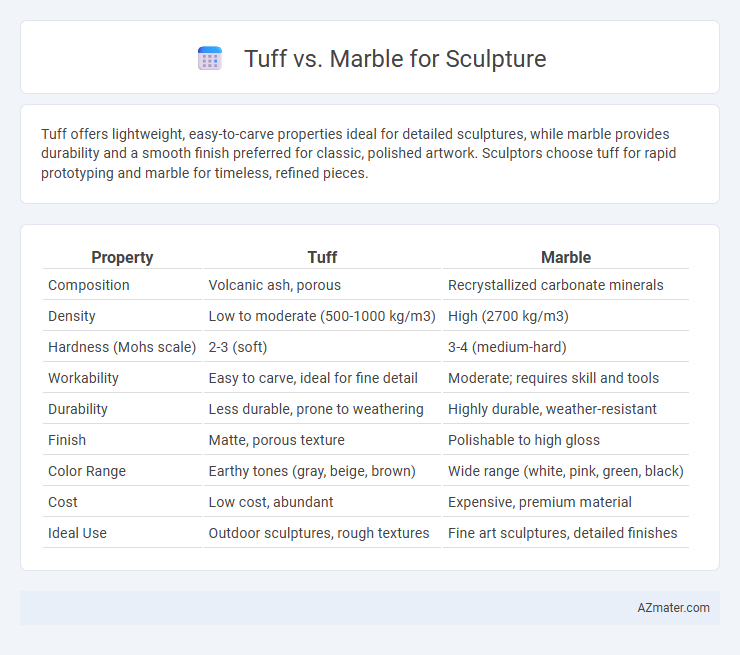Tuff offers lightweight, easy-to-carve properties ideal for detailed sculptures, while marble provides durability and a smooth finish preferred for classic, polished artwork. Sculptors choose tuff for rapid prototyping and marble for timeless, refined pieces.
Table of Comparison
| Property | Tuff | Marble |
|---|---|---|
| Composition | Volcanic ash, porous | Recrystallized carbonate minerals |
| Density | Low to moderate (500-1000 kg/m3) | High (2700 kg/m3) |
| Hardness (Mohs scale) | 2-3 (soft) | 3-4 (medium-hard) |
| Workability | Easy to carve, ideal for fine detail | Moderate; requires skill and tools |
| Durability | Less durable, prone to weathering | Highly durable, weather-resistant |
| Finish | Matte, porous texture | Polishable to high gloss |
| Color Range | Earthy tones (gray, beige, brown) | Wide range (white, pink, green, black) |
| Cost | Low cost, abundant | Expensive, premium material |
| Ideal Use | Outdoor sculptures, rough textures | Fine art sculptures, detailed finishes |
Introduction to Tuff and Marble in Sculpture
Tuff is a volcanic rock known for its softness and ease of carving, making it a popular choice for sculptors seeking detailed work with less effort. Marble, a metamorphic rock composed primarily of calcite, is prized for its durability, fine grain, and ability to achieve a polished, smooth finish. Both materials hold significant historical importance in sculpture, but their physical properties influence the techniques and longevity of the artwork.
Geological Origins: Tuff vs Marble
Tuff is a volcanic rock formed from consolidated volcanic ash ejected during explosive eruptions, characterized by its porous texture and relatively softer composition, making it easier to carve. Marble originates from the metamorphism of limestone under intense heat and pressure, resulting in a dense, crystalline structure with a smooth surface and distinctive veining, prized for its durability and aesthetic appeal in sculpture. The geological origins of tuff and marble significantly influence their physical properties, with tuff's volcanic nature providing lightweight, porous material, while marble's metamorphic process yields a harder, more polished medium favored in classical sculpture.
Physical Properties Comparison
Tuff is a volcanic rock characterized by low density and high porosity, making it lightweight and easier to carve compared to marble, which is denser and has a fine-grained crystalline structure. Marble's hardness and smooth texture provide superior durability and a polished finish, ideal for detailed and lasting sculptures. The moisture absorption rate of tuff is higher, often leading to faster weathering, whereas marble's lower porosity enhances its resistance to environmental elements.
Workability and Carving Techniques
Tuff stone offers superior workability due to its softness and fine-grain texture, allowing sculptors to achieve intricate details with ease using basic chisels and rasps. Marble, while harder and denser, requires advanced carving techniques, often involving pneumatic tools and finer abrasives to attain smooth finishes and sharp edges. The choice between tuff and marble directly influences the sculpting process, with tuff favoring quicker shaping and marble enabling more polished, durable results.
Aesthetic Qualities and Visual Appeal
Tuff offers a warm, porous texture with soft, earthy tones that enhance the naturalistic and rustic aesthetic of sculptures, making it ideal for organic, flowing forms. Marble features a smooth, polished surface with a luminous quality and distinctive veining, providing a classical elegance and refined visual appeal that highlights intricate details. Sculptors often choose marble for its ability to capture light and emphasize depth, while tuff is preferred for textured, tactile artworks that evoke a sense of raw nature.
Durability and Longevity in Artworks
Tuff offers exceptional durability due to its volcanic origin, making it highly resistant to weathering and erosion, which ensures longevity in outdoor sculptures. Marble, prized for its classic beauty and fine grain, is softer and more susceptible to acid rain and physical wear over time, affecting its durability. Artists seeking long-lasting outdoor artworks often prefer Tuff for its resilience, while marble remains favored for indoor or protected sculptures where erosion is minimal.
Historical Use in Sculptures
Tuff, a volcanic rock primarily composed of compacted volcanic ash, was widely utilized in ancient Roman and Etruscan sculptures due to its ease of carving and availability. Marble, particularly prized since classical antiquity, became the preferred medium for Greek and Roman sculptors for its fine grain and durability, allowing intricate detail and smooth finishes. Historical archeological sites across the Mediterranean showcase tuff sculptures as more abundant but less refined compared to the enduring elegance and detail of marble statues.
Cost and Accessibility
Tuff offers a cost-effective alternative to marble, making it popular among sculptors with budget constraints due to its lower price and easier procurement. Marble, while more expensive and less accessible, is prized for its fine grain and durability, often justifying the higher investment for detailed, long-lasting sculptures. Accessibility to tuff is generally higher in volcanic regions, whereas marble sourcing depends on specific quarries, influencing overall project logistics and expenses.
Environmental Impact of Quarrying
Tuff quarrying generally has a lower environmental impact compared to marble due to its softer nature, requiring less energy-intensive extraction methods. Marble quarrying demands significant energy consumption and produces more dust and waste, contributing to habitat disruption and increased carbon emissions. Selecting tuff over marble for sculpture minimizes ecological disturbances and reduces the carbon footprint linked to stone extraction.
Choosing Between Tuff and Marble for Sculpture
Choosing between tuff and marble for sculpture depends on factors like hardness, texture, and durability. Tuff, a volcanic rock, is softer and easier to carve, making it ideal for detailed work and beginners, but it is less durable and more porous than marble. Marble offers a smooth, fine grain and greater longevity, favored for classical sculptures requiring polish and strength, but it demands more skill and tools to shape effectively.

Infographic: Tuff vs Marble for Sculpture
 azmater.com
azmater.com